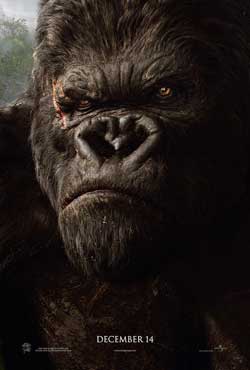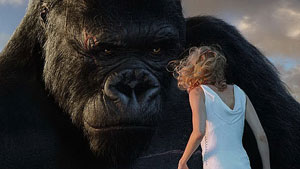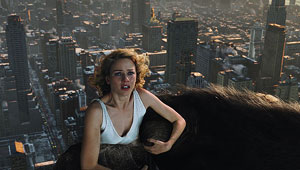 King Kong rampages into theaters tonight, and we’re going to be bringing you the rest of our massive coverage the rest of this week. You’ve probably already read the Peter Jackson interview (click here if you haven’t, you naughty thing), today it’s time for the beauty that killed the beast, Naomi Watts.
King Kong rampages into theaters tonight, and we’re going to be bringing you the rest of our massive coverage the rest of this week. You’ve probably already read the Peter Jackson interview (click here if you haven’t, you naughty thing), today it’s time for the beauty that killed the beast, Naomi Watts.
By the way, the latest installment of the Kong Production Diaries covers the press junket. If you watch the clip – which you can do by clicking here – you’ll see Peter Jackson coming into the online press room, and you’ll see the back of me in the front row. I’m famous!
Q: Was Peter Jackson important for your decision to take this role?
Watts: I don’t think I could have signed onto this project if it hadn’t been someone like Peter. I would have been concerned that it would have just been too much of an action movie and a damsel in distress. But when I first heard about it and I heard that Peter was doing it, I thought “Oh, wow, that’s interesting.” The guy who is pretty much the frontrunner, in terms of the effects world, as well a man who made Heavenly Creatures, which is a beautifully complicated movie about very emotional stuff. So it seemed like a great idea, and I went and met with him and his partner Fran Walsh and Phillipa Boyens, their writing partner. I heard them speak about it, that it was the legendary King Kong, but with a number of great new ideas, and how they definitely wanted to change the female role into something much more than just a screaming beauty.
Q: What kind of emotion is running through your head in the scenes where Anne is showing love for Kong? What kind of love would you say it is?
Watts: It’s definitely not lust like the 70s version. It’s more pure and caring and paternal. I mean, in the way that they see each other and identify with each other that they’re two lonely beings, and I think they kind of understand each other in a way, and that they’ve struggled and been through desperate times. The first moment I think that they make that connection is when, instead of making the decision to pull her to pieces, he thinks she’s kind of amusing and she pushes her around a bit, and then, because of her days of vaudeville, she kind of cottons on to what he’s amused by and this is going to buy her more time, basically. And all the time, she’s thinking “Okay, I’ll just do a couple pratfalls and think of a way out of this,” but then she kind of sees what it is that is amusing him and finds that kind of fascinating. He becomes like obsessed with it and wanting more and more and more, and  she’s beyond exhaustion and can’t give any more and then he gets frustrated and starts smashing things, and then becomes completely embarrassed by his behavior and has to run away and hide. And she finds that odd, but kind of understands it as well. In fact, that’s sort of the beginning of their connection.
she’s beyond exhaustion and can’t give any more and then he gets frustrated and starts smashing things, and then becomes completely embarrassed by his behavior and has to run away and hide. And she finds that odd, but kind of understands it as well. In fact, that’s sort of the beginning of their connection.
Q: This role has become iconic in the careers of Fay Wray and Jessica Lange. Are you ready for it to loom over your career?
Watts: I don’t know, because it hasn’t happened yet, but one of my fears in the beginning of taking on the part was that this is such an iconic movie and an iconic part, and how do you survive those comparisons that are naturally going to be drawn. But then I also felt that I had done quite a bit of work beforehand. Maybe it won’t be just this one role that people will think of me as. I’ll continue to do lots of other diverse work as well. This is just different for me and it was fun. It’s an adventurous film with all kinds of other elements.
Q: How important was it to have Andy Serkis on set playing Kong?
Watts: Oh, so important. I couldn’t have done it without him, because truly, if I had…yeah, I can’t imagine. I really can’t imagine.
Q: Can you tell us what the interaction was like?
Watts: It was as if he was a character, like playing opposite any other man. He didn’t have any words, but he had a huge amount of expression, be it physical or emotional, so I just was reacting to him the whole time and in as truthful a way as possible.
Q: Was he in full monkey mode?
Watts: He wasn’t in a monkey suit with fur all over it. He was in a special suit that helped him move a sort of way. It was more about giving him the structure and posture that a primate has. He had teeth in because that helped him and he also had a microphone and this thing they called the “Kongalizer” that did something to change the vibrational frequency in his own voice, but every thing that you see on the screen is Andy Serkis. Yes, there’s been some magical stuff happen in the post-production and special effects, but all the emotion, all the movement, you know how you see that ferocious face turn from that to sort of a smile [with] a light in his eyes, that’s all Andy. And that’s what I was reacting to, so that’s why it felt like a normal workspace for me.
Q: The ice skating scene is one of the best in the film. Can you talk about that scene?
Watts: We shot that scene in the reshoots. Andy and Peter went into motion capture and I think Andy had the idea that wouldn’t it be great to see them have their last loving moment? And Peter loved the idea and I guess he built on it from there. I mean, I think it just makes so much sense to go from all that chaos and then have a moment of reprieve, and then obviously, you’re going back into the chaos again. Yeah, it worked really well. They sat me in this piece…I mean, it’s basically a seat with a piece of foam around me and it’s on a… I don’t even know these technical names. I was there for seven months but they didn’t stick! Anyway, they move you around slowly as you gently walk through the park and then as we’re falling, the chair moves a little bit more and then that same device worked for many other scenes, you know, when he’s shaking me. It changed speed, but the hand always remained the same.
think Andy had the idea that wouldn’t it be great to see them have their last loving moment? And Peter loved the idea and I guess he built on it from there. I mean, I think it just makes so much sense to go from all that chaos and then have a moment of reprieve, and then obviously, you’re going back into the chaos again. Yeah, it worked really well. They sat me in this piece…I mean, it’s basically a seat with a piece of foam around me and it’s on a… I don’t even know these technical names. I was there for seven months but they didn’t stick! Anyway, they move you around slowly as you gently walk through the park and then as we’re falling, the chair moves a little bit more and then that same device worked for many other scenes, you know, when he’s shaking me. It changed speed, but the hand always remained the same.
Q: A lot of people poo poo the 1976 version. Had you seen it and was there anything you could learn from Jessica Lange’s performance that you used or avoided?
Watts: Yeah, I mean, they do poo poo it, I think because of the sexual undertones in it, but I saw that a long time ago, and I’m still very moved by her performance. I mean, I’ve always loved Jessica’s work, and actually, it reminded me even when the story falters, the role is fabulous and if it’s done right, then it still works. But Peter’s passion was for the original and that’s what he fell in love with at 9 years old and that’s what made him want to be a filmmaker.
Q: What’s the difference between working on somebody’s dream project and any other film?
Watts: Yeah, well that was another thing that just got me going. When someone has that much passion for a project, you know, it’s great, it’s just wonderful to be part of the excitement. He’s just loved it for all that time and he’s so invested. From that initial meeting in London when they invited me to dinner, and he had images…he could just talk so  wonderfully about the characters, and who Kong is, I just thought…yeah, I want to do this. I want to work with a man with that much passion and vision.
wonderfully about the characters, and who Kong is, I just thought…yeah, I want to do this. I want to work with a man with that much passion and vision.
Q: Did you get caught up in it and fall in love with the 1933 version?
Watts: Yeah, I did, but I also knew that although he wanted to honor that version, he had so many great new ideas that would make it modern and its own thing.